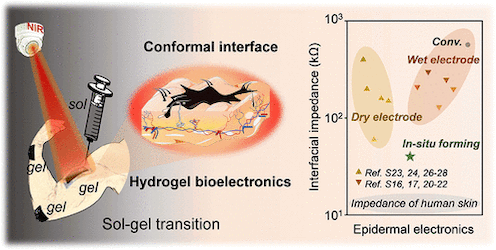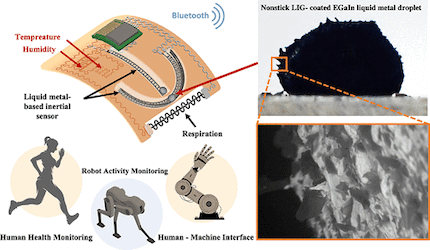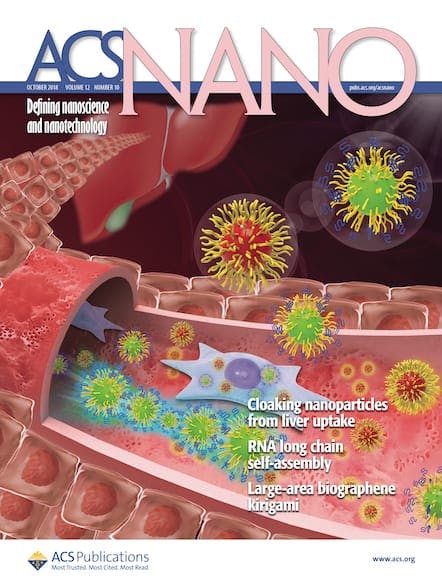New advances in flexible electronics and interfaces could unleash a higher-performing—and more comfortable—generation of wearable devices.

Since 2016, the number of connected wearable devices worldwide has tripled, growing from 325 million to more than 1 billion in 2022.1 The smart watches and wearable devices of today go far beyond simply telling time or counting our daily steps. At this very moment, it’s likely your wearable device is measuring your resting heart rate while simultaneously serving up messages and notifications—and last night, it may have tracked variables such as your sleep quality, skin temperature, and oxygen saturation.
Wearables and epidermal bioelectronics have become entrenched in our lives as we increasingly gamify our health, and they are becoming essential for monitoring conditions such as diabetes and heart arrhythmia. But what are their current limiting factors, and how much further could they go with the right innovations?
A Second Skin
Human skin is one of the most effective communicators of the human body, providing an array of physiological and biochemical signals that align closely with a person’s health status. This information is important for health monitoring, clinical diagnoses, and treatment, but collecting it noninvasively while achieving both comfort and accuracy remains a challenge. A key limiting factor is the nonconformal contact between relatively stiff epidermal bioelectronics and soft biological surfaces, which may result in weakened signals and inaccurate readings.
Traditional functional components for electronics include metals, semiconductors, and ceramic materials—all of which typically are neither flexible nor permeable. Various malleable and stretchable materials can be used as supporting substrates for electronics, including thin films made of plastics or elastomers, but these are also often impermeable to moisture vapor or gases.
One important advance in developing next-generation wearables could therefore be permeable, breathable electronics. This novel solution has potential to overcome the disparity between rigid electronics and soft human tissues, enabling a much more comfortable user experience. Furthermore, wearable electronics capable of permeating gas or liquid would also be a significant boon for wellness and medical applications, ensuring a biocompatible interface for continuous, real-time health monitoring.2

For on-body continuous monitoring, devices need to perform without deterioration or noise when worn in a sweaty environment over a long period. Permeable materials and structures should also offer flexible and adhesive characteristics similar to those of the target tissues, enabling devices to be fully wrapped around or conformed to the human body for reliable and durable performance functioning.
One recent study published in ACS Nano explores the benefits of hydrogels as a solution for a flexible skin–device interface. The authors report that their findings could aid in the design of more advanced bioelectronics for health monitoring, prosthesis control, and even brain-computer interfaces.3

While the creation of a soft, permeable interface solves one problem, it creates new ones for other elements within a wearable. For example, existing inertial-based motion sensors and accelerometers rely on rigid beams, which limits their use in soft wearables and interfaces. Further research describes a stand-alone, fully soft motion sensor that provides continuous skin contact and high functionality, based on graphene-coated liquid metal-based inertial sensors in a 3D channel architecture.4

By continuing to push these technological boundaries, researchers are coming up with new ways for wearables to serve us, and many of these advances are beginning to come to market. Today, we see devices that can detect and raise the alarm for accidents; tomorrow we may have wireless strain sensors that can remotely monitor water activities and alert others when someone is drowning.5 That’s quite a feat for a watch. But perhaps we have only scraped the surface of what these devices can do for us.
Explore Related Research in ACS Journals
Stretchable Sponge Electrodes for Long-Term and Motion-Artifact-Tolerant Recording of High-Quality Electrophysiologic Signals
DOI: 10.1021/acsnano.2c04962
Breathable, Wireless, Thin-Film Wearable Biopatch Using Noise-Reduction Mechanisms
DOI: 10.1021/acsaelm.1c01107
Woven Structured Triboelectric Nanogenerator for Wearable Devices
DOI: 10.1021/am504110u
Electronic Textiles for Wearable Point-of-Care Systems
DOI: 10.1021/acs.chemrev.1c00502
Achievements and Challenges for Real-Time Sensing of Analytes in Sweat within Wearable Platforms
DOI: 10.1021/acs.accounts.8b00555
References
- Connected Wearable Devices Worldwide 2016-2022.
- Huang, Q. and Zheng, Z. Pathway to Developing Permeable Electronics. ACS Nano 2022, 16, 10, 15537–15544.
- Tang, H. et al. In Situ Forming Epidermal Bioelectronics for Daily Monitoring and Comprehensive Exercise. ACS Nano 2022, 16, 11, 17931–17947.
- Babatain, W. et al. Graphene and Liquid Metal Integrated Multifunctional Wearable Platform for Monitoring Motion and Human–Machine Interfacing. ACS Nano 2022, 16, 12, 20305–20317.
- Zhu, T. et al. A Breathable Knitted Fabric-Based Smart System with Enhanced Superhydrophobicity for Drowning Alarming. ACS Nano 2022, 16, 11, 18018–18026.
